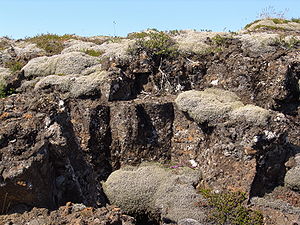Racomitrium
| Racomitrium | ||||||||||||
|---|---|---|---|---|---|---|---|---|---|---|---|---|

Racomitrium lanuginosum |
||||||||||||
| Systematics | ||||||||||||
|
||||||||||||
| Scientific name | ||||||||||||
| Racomitrium | ||||||||||||
| Brid. |
Racomitrium (German: Zackenmützenmoos ) is a genus of deciduous mosses from the subfamily Racomitrioideae within the family Grimmiaceae .
To delimit the genus Racomitrium, see the Systematics section below. The description given here follows that of Frey and Stech, i.e. racomitrium in the narrower sense.
features
The plants are medium to large in size, stiff, usually whitish, gray, yellow- or brown-green to dark brown, the mostly pinnately branched stems have many short, lateral short shoots. The leaves are dry upright to slightly one-sided, moist upright and protruding to arched back, narrowly ovate to narrowly lanceolate and gradually narrowing into a long, slender, hyaline glass tip. The tips of the glass are dented and toothed, densely papillary and long running down the upper, roughly toothed edges of the leaves. Further down, the leaf margins are entire and bent back until rolled back. The leaf vein extends to the tip of the leaf and is three-celled at the bottom and two-celled at the top.
The lamina cells are bulging, opaque and papillae, with the large and flat papillae above the cell walls and also covering the edge areas of the cells, so that only the cell center remains free. The basal leaf margins have one or sometimes two rows of up to 30 rectangular, transparent, smooth-walled cells. Leaf-wing cells are not particularly differentiated. The cells in the middle of the leaf are long-rectangular, in the upper leaf area they are short-rectangular.
The seta is strongly papillosome, the spore capsule straight, ovate to ovoid-cylindrical and somewhat bulbous at the base, the lid with long beaks, the kalyptra is bare. The peristome teeth are divided down to the bottom into two, sometimes three, thread-like, strongly papillary branches.
The genus is cosmopolitan.
Systematics
Traditionally, the genus Racomitrium (in the broader sense) was characterized by lamina cells that were bulky to nodular, a trunk cross-section without a central cord and the capsular teeth divided almost to the base into two to three thread-like, papillary segments.
According to recent research, the genus Racomitrium (in the former broader sense) was created by Ochyra et al. 2003 divided into four genera: Bucklandiella , Codriophorus , Niphotrichum and Racomitrium (in the narrower sense, as described in this article).
Species list
The information on the number of species is different: according to Stech and Frey there are 14 species, according to the flora of North America there are only 3.
Only one species is represented in Europe:
swell
- Wolfgang Frey , Michael Stech, Eberhard Fischer: Bryophytes and Seedless Vascular Plants (= Syllabus of Plant Families. 3). 13th edition. Borntraeger, Berlin et al. 2009, ISBN 978-3-443-01063-8 .
- Racomitrium in www.efloras.org .
Individual evidence
- ↑ Wolfgang Frey, Michael Stech, Eberhard Fischer: Bryophytes and Seedless Vascular Plants (= Syllabus of Plant Families. 3). 13th edition. Borntraeger, Berlin et al. 2009, ISBN 978-3-443-01063-8 , p. 159.